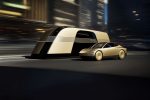
Elon Musk Reveals Tesla ‘Cybercab’ Robotaxi and ‘Robovan’
Tesla has once again made headlines in the automotive world. During a Hollywood event, Elon Musk revealed two exciting new additions to the Tesla lineup: the Cybercab Robotaxi and the Robovan. These vehicles offer a new vision of fully autonomous transportation, sparking curiosity and debate across the industry.
The Cybercab is A Sleek Robotaxi for the Future
The Cybercab is Tesla’s latest step toward a fully autonomous future. This two-door coupe borrows design elements from the Cybertruck but is far smaller and more aerodynamic. With its butterfly doors and compact size, the Cybercab looks like something straight out of a sci-fi movie.
Key features include:
No Steering Wheel or Pedals: The Cybercab is entirely autonomous, with no need for a driver. Instead, the dashboard features a large screen in the center, controlling the vehicle’s functions.
Inductive Charging: This feature means no plugging in to charge the vehicle. The car recharges wirelessly, making it even more convenient for users.
Pricing: Musk has hinted that the Cybercab will be available to the public for under $30,000, making it accessible to a broader audience.
However, Tesla didn’t provide performance or range specs for the Cybercab, leaving many unanswered questions. While the Cybercab’s debut generated buzz, we may need to wait until 2026 to see these cars on the road. Musk himself admitted that Tesla’s delivery timelines have often been overly optimistic in the past, so delays could be expected.
The Robovan Moves People Autonomously
In addition to the Cybercab, Musk introduced the Robovan, an electric van designed to transport larger groups autonomously. While details are still scarce, it seems capable of fitting over 10 passengers. Tesla has yet to confirm whether this van will be available for purchase by the general public.
Key takeaways:
Autonomous People Mover: The Robovan aims to transport groups of people efficiently and without human input.
No Specifics Yet: No technical specifications have been released, but the potential for mass transit solutions is intriguing.
Tesla’s Autonomous Vision and What’s Next?
Tesla has been pushing the boundaries of autonomous driving for years, and these new vehicles represent the next steps in that evolution. The company plans to begin fully autonomous operations with its current Model 3 and Model Y vehicles in California and Texas next year. However, the Cybercab and Robovan are not expected to hit the streets until 2026 at the earliest.
Musk’s ambitious vision for the future of transportation is exciting, but the long history of delayed rollouts for Tesla products makes it clear that patience will be needed. As more video footage from test rides in the Cybercab becomes available, the hype surrounding these vehicles is likely to grow.
Regulatory Challenges: Fully autonomous vehicles will face significant hurdles in gaining approval from regulators, especially in dense urban areas.
Infrastructure Needs: Charging networks will need to expand, especially for inductive charging systems like those in the Cybercab.
Public Reception: Will consumers embrace autonomous cars, or will safety concerns and trust issues hold back widespread adoption?
Tesla’s unveiling of the Cybercab Robotaxi and Robovan is another bold move in the company’s quest to revolutionize transportation. With autonomous driving technology advancing rapidly, the next few years will be critical in determining whether these futuristic vehicles can live up to their potential.
The wait may be long, but Tesla’s vision continues to push the boundaries of what’s possible in the automotive world.


